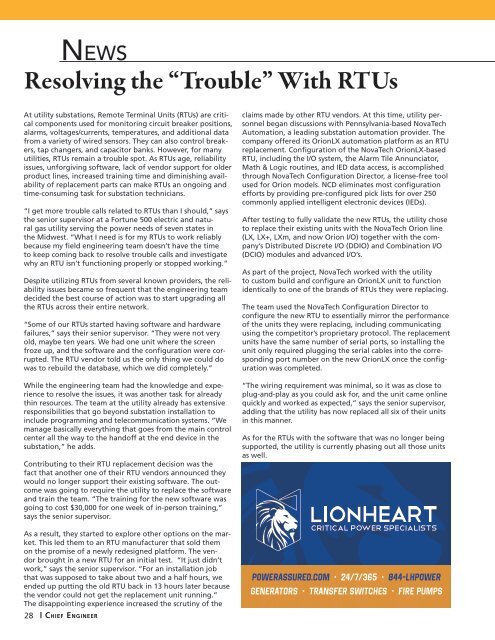CEAC-2022-02-February
Create successful ePaper yourself
Turn your PDF publications into a flip-book with our unique Google optimized e-Paper software.
News<br />
Resolving the “Trouble” With RTUs<br />
At utility substations, Remote Terminal Units (RTUs) are critical<br />
components used for monitoring circuit breaker positions,<br />
alarms, voltages/currents, temperatures, and additional data<br />
from a variety of wired sensors. They can also control breakers,<br />
tap changers, and capacitor banks. However, for many<br />
utilities, RTUs remain a trouble spot. As RTUs age, reliability<br />
issues, unforgiving software, lack of vendor support for older<br />
product lines, increased training time and diminishing availability<br />
of replacement parts can make RTUs an ongoing and<br />
time-consuming task for substation technicians.<br />
“I get more trouble calls related to RTUs than I should,” says<br />
the senior supervisor at a Fortune 500 electric and natural<br />
gas utility serving the power needs of seven states in<br />
the Midwest. “What I need is for my RTUs to work reliably<br />
because my field engineering team doesn’t have the time<br />
to keep coming back to resolve trouble calls and investigate<br />
why an RTU isn’t functioning properly or stopped working.”<br />
Despite utilizing RTUs from several known providers, the reliability<br />
issues became so frequent that the engineering team<br />
decided the best course of action was to start upgrading all<br />
the RTUs across their entire network.<br />
“Some of our RTUs started having software and hardware<br />
failures,” says their senior supervisor. “They were not very<br />
old, maybe ten years. We had one unit where the screen<br />
froze up, and the software and the configuration were corrupted.<br />
The RTU vendor told us the only thing we could do<br />
was to rebuild the database, which we did completely.”<br />
While the engineering team had the knowledge and experience<br />
to resolve the issues, it was another task for already<br />
thin resources. The team at the utility already has extensive<br />
responsibilities that go beyond substation installation to<br />
include programming and telecommunication systems. “We<br />
manage basically everything that goes from the main control<br />
center all the way to the handoff at the end device in the<br />
substation,” he adds.<br />
Contributing to their RTU replacement decision was the<br />
fact that another one of their RTU vendors announced they<br />
would no longer support their existing software. The outcome<br />
was going to require the utility to replace the software<br />
and train the team. “The training for the new software was<br />
going to cost $30,000 for one week of in-person training,”<br />
says the senior supervisor.<br />
As a result, they started to explore other options on the market.<br />
This led them to an RTU manufacturer that sold them<br />
on the promise of a newly redesigned platform. The vendor<br />
brought in a new RTU for an initial test. “It just didn’t<br />
work,” says the senior supervisor. “For an installation job<br />
that was supposed to take about two and a half hours, we<br />
ended up putting the old RTU back in 13 hours later because<br />
the vendor could not get the replacement unit running.”<br />
The disappointing experience increased the scrutiny of the<br />
28 | Chief Engineer<br />
claims made by other RTU vendors. At this time, utility personnel<br />
began discussions with Pennsylvania-based NovaTech<br />
Automation, a leading substation automation provider. The<br />
company offered its OrionLX automation platform as an RTU<br />
replacement. Configuration of the NovaTech OrionLX-based<br />
RTU, including the I/O system, the Alarm Tile Annunciator,<br />
Math & Logic routines, and IED data access, is accomplished<br />
through NovaTech Configuration Director, a license-free tool<br />
used for Orion models. NCD eliminates most configuration<br />
efforts by providing pre-configured pick lists for over 250<br />
commonly applied intelligent electronic devices (IEDs).<br />
After testing to fully validate the new RTUs, the utility chose<br />
to replace their existing units with the NovaTech Orion line<br />
(LX, LX+, LXm, and now Orion I/O) together with the company’s<br />
Distributed Discrete I/O (DDIO) and Combination I/O<br />
(DCIO) modules and advanced I/O’s.<br />
As part of the project, NovaTech worked with the utility<br />
to custom build and configure an OrionLX unit to function<br />
identically to one of the brands of RTUs they were replacing.<br />
The team used the NovaTech Configuration Director to<br />
configure the new RTU to essentially mirror the performance<br />
of the units they were replacing, including communicating<br />
using the competitor’s proprietary protocol. The replacement<br />
units have the same number of serial ports, so installing the<br />
unit only required plugging the serial cables into the corresponding<br />
port number on the new OrionLX once the configuration<br />
was completed.<br />
“The wiring requirement was minimal, so it was as close to<br />
plug-and-play as you could ask for, and the unit came online<br />
quickly and worked as expected,” says the senior supervisor,<br />
adding that the utility has now replaced all six of their units<br />
in this manner.<br />
As for the RTUs with the software that was no longer being<br />
supported, the utility is currently phasing out all those units<br />
as well.<br />
Powerassured.com • 24/7/365 • 844-LHPOWER<br />
Generators • Transfer Switches • Fire Pumps


















